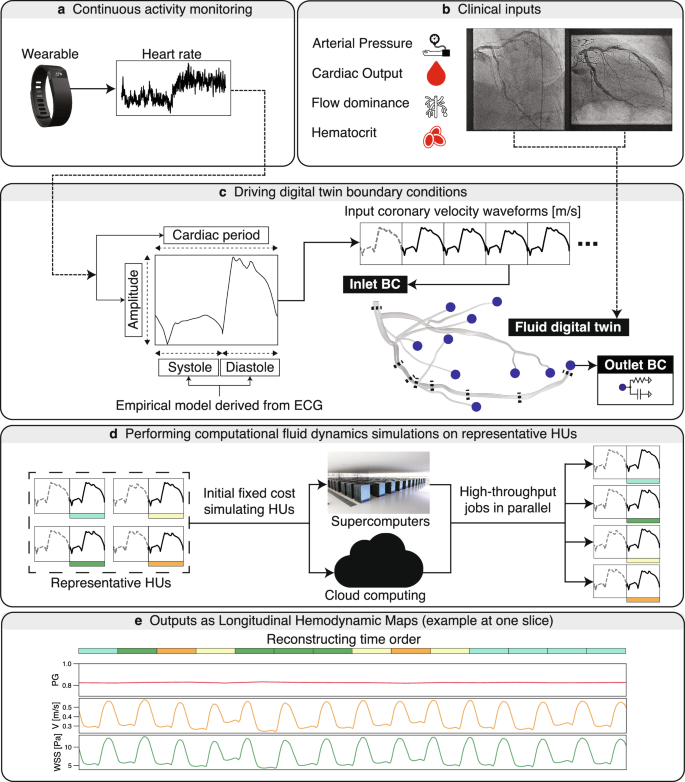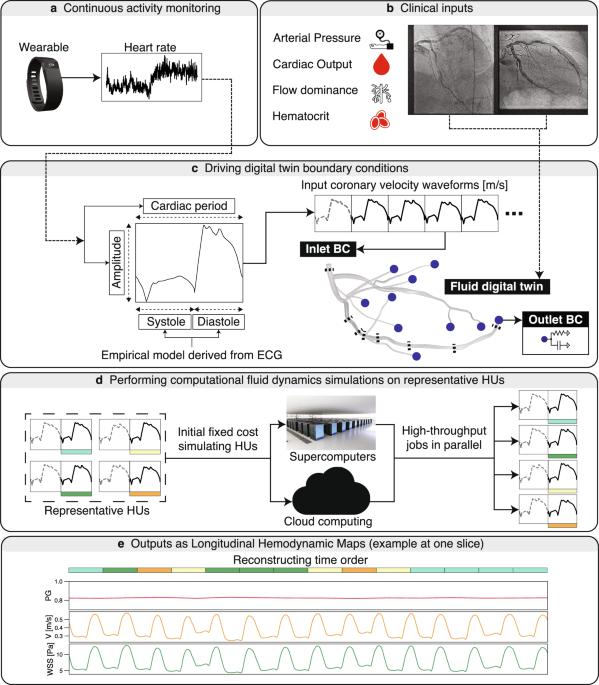Establishing the longitudinal hemodynamic mapping framework for wearable-driven coronary digital twins
IF 15.1
1区 医学
Q1 HEALTH CARE SCIENCES & SERVICES
引用次数: 0
Abstract
Understanding the evolving nature of coronary hemodynamics is crucial for early disease detection and monitoring progression. We require digital twins that mimic a patient’s circulatory system by integrating continuous physiological data and computing hemodynamic patterns over months. Current models match clinical flow measurements but are limited to single heartbeats. To this end, we introduced the longitudinal hemodynamic mapping framework (LHMF), designed to tackle critical challenges: (1) computational intractability of explicit methods; (2) boundary conditions reflecting varying activity states; and (3) accessible computing resources for clinical translation. We show negligible error (0.0002–0.004%) between LHMF and explicit data of 750 heartbeats. We deployed LHMF across traditional and cloud-based platforms, demonstrating high-throughput simulations on heterogeneous systems. Additionally, we established LHMFC, where hemodynamically similar heartbeats are clustered to avoid redundant simulations, accurately reconstructing longitudinal hemodynamic maps (LHMs). This study captured 3D hemodynamics over 4.5 million heartbeats, paving the way for cardiovascular digital twins.


为可穿戴式冠状动脉数字双胞胎建立纵向血液动力学绘图框架
了解冠状动脉血液动力学不断变化的性质对于早期疾病检测和监测进展至关重要。我们需要数字双胞胎,通过整合连续的生理数据和计算数月的血液动力学模式来模拟患者的循环系统。目前的模型与临床血流测量相匹配,但仅限于单次心跳。为此,我们引入了纵向血液动力学映射框架(LHMF),旨在解决以下关键难题:(1)显式方法的计算难点;(2)反映不同活动状态的边界条件;(3)临床转化所需的可访问计算资源。我们发现 LHMF 与 750 次心跳的显式数据之间的误差可以忽略不计(0.0002-0.004%)。我们在传统平台和云平台上部署了 LHMF,在异构系统上演示了高吞吐量模拟。此外,我们还建立了 LHMFC,将血流动力学相似的心跳集中在一起以避免冗余模拟,从而准确重建纵向血流动力学图(LHM)。这项研究捕捉了 450 万次心跳的三维血流动力学,为心血管数字双胞胎铺平了道路。
本文章由计算机程序翻译,如有差异,请以英文原文为准。
求助全文
约1分钟内获得全文
求助全文
来源期刊

NPJ Digital Medicine
Multiple-
CiteScore
25.10
自引率
3.30%
发文量
170
审稿时长
15 weeks
期刊介绍:
npj Digital Medicine is an online open-access journal that focuses on publishing peer-reviewed research in the field of digital medicine. The journal covers various aspects of digital medicine, including the application and implementation of digital and mobile technologies in clinical settings, virtual healthcare, and the use of artificial intelligence and informatics.
The primary goal of the journal is to support innovation and the advancement of healthcare through the integration of new digital and mobile technologies. When determining if a manuscript is suitable for publication, the journal considers four important criteria: novelty, clinical relevance, scientific rigor, and digital innovation.
 求助内容:
求助内容: 应助结果提醒方式:
应助结果提醒方式:


